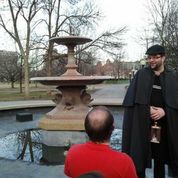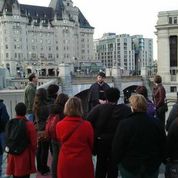Post Conference Review #5: The Haunted Walk
05 June 2013 – Jill Dolan
Editor’s note: This post continues the series of conference city reviews published byThe Public Historian in the Public History Commons
The Haunted Walk, April 17, 2013. NCPH Annual Meeting, Ottawa, Ontario, Canada. Created by Haunted Walks, Inc.; Glen Shackleton, Founder; Denis Lamoureux, Guide.
I must admit I approached reviewing the Haunted Ottawa walking tour with a bit of trepidation. Not for fear of the ghosts, and not because I don’t enjoy these kinds of tours—I do. But because the take-away historical information from most tours seems inextricably bound to the performance/story telling ability of the guide and I didn’t want to write an entertainment review. A tight corner to be in; the tour was fun, and entertaining, and the guide was very good. But The Public Historian’s interest in reviewing conference city excursions is to discuss the effectiveness of the conveyance of local history through less conventional methods, and, I would argue, whether looking at architecture or looking for ghosts, the effectiveness of the method should not rely on the performance ability of the messenger, but rather on the consistency or replicability of the tour text.
Consistency is difficult to assess after attending only one tour but the “evidence” suggests Haunted Walks, Inc. has found a way to achieve it. That evidence is not as elusive as some of the evening’s ghosts (we didn’t see any). All Haunted Walks, Inc. tours are scripted, and, according to company founder Glen Shackleton, scripts are based on well researched, documented paranormal experiences. His team looks through archives, contemporaneous reports in newspapers, and through secondary sources before they add a haunting to their line-up. Delivery, too, is an important consideration, and among his storyteller staff some have backgrounds in history, with day jobs as museum employees, grad students, and actors. As they gain experience with a tour, they may add their own flair to their presentations, but the core material remains the same. Shackleton argues that this attention to detail—both in scripting and delivery—provides a level of accuracy and consistency that sets his company apart from others, and that Haunted Walks may be, in his words, “the biggest walking tour company in Canada.” They must be doing something right.[1]

Haunted Walk, Inc. guides are distinguished by their capes and lanterns. Here, guide Denis
Lamoureaux has gathered us in Ottawa’s Confederation Park. (Photo courtesy of Richard
Harker.)
On the evening of our tour a group of conference attendees, starting out as strangers, wandered through downtown Ottawa in the gathering gloaming following behind lantern-toting guide Denis Lamoureux. As the sun went down and the night grew chill we strangers became close, huddling together in doorways and in front of buildings, whether for warmth or solidarity against the unknown I cannot say. Denis did not sound scripted—perhaps he has graduated to the level of adding his own flair. He had a solid delivery and managed to intone the right level of suspense at the punch line of every story.
What an urban walking tour does best is make the participants look at the buildings around them. We are directed to take our eyes off our feet and look up, above the frequently altered street level façades, to see the building above us and to better understand its place on the urban landscape. In our drive-by societies, buildings are blurs, and we pass them by faster than time itself. A walking tour slows us down, focuses our attention. We look up. This is as true of a ghost walk as of an architectural tour, the difference being that instead of trying to figure out which of those windows up there is the Palladian window and which one the rose, you are directed look for unsettled souls who may be lurking in the windows above you.
O.K. I slowed down. I looked up. I had a good time. But, despite Shackleton’s research, and whether or not one believes in ghosts, does a haunted tour convey “history”? Do tidbits of information constitute historical knowledge? Does a morsel make a meal?
Sitting down to dinner after the tour with a handful of my newly acquainted colleagues, we deconstructed the excursion. They were interested in what kind of a review I would write. “I liked it,” I said… “But is it history?”A chorus of yeses went up as my colleagues argued in favor of something as seemingly frivolous as a haunted walking tour counting as history. Using the “haunted” hook, they argued, tour attendees learn about the popular lore and culture of a place; they learn some urban history; they form a stronger bond with their communities and might develop the habit of “looking.” All good arguments. Off the top of my head I can recall that Ottawa’s business blocks were built on the forgotten graves of canal workers, many of whom died of swamp fever; that the builder of the luxury Château Laurier Hotel perished on the Titanic, his death delaying the opening of the hotel; that part of city hall was once the Normal School and that determined female teachers may still be holding classes within. I can even work in some historical context for all of this, although I may have brought that some of that knowledge with me. Perhaps, as my colleagues and Glen Shackleton would say, I learned some history in spite of myself.

Château Laurier looms at the left of this photo, as Denis tells us tales of its haunting. (Photo
courtesy of Richard Harker.)
I am content with my haunted excursion into Ottawa’s history, although for me the jury is still out as to whether this tour—or any tour—conveys history or serves the preliminary, invaluable service of piquing an interest in history. Mine was certainly piqued in Ottawa. I went back the next day and walked down to the Bytown Museum and wandered around the Château Laurier—although thinking about the tour from the night before, and being without the support of my colleagues, I did not take the elevator to the fifth floor where the paranormal essence is said to be very strong. Maybe next time.
~ Jill Patrice Dolan, University of California, Santa Barbara
[1] Glen Shackleton, interview with the author, April 9, 2013. Shackleton majored in history and admits to being passionate about the subject. In addition to his work at Haunted Walks, Inc. he is on the Board of Directors of Ottawa’s historic Bytown Museum—which is also haunted.




Thanks for this fine write-up! I admit I’ve never been on a ghost tour, but I did very much enjoy a session about them at the Future of Civil War Studies conference in Gettysburg this past spring. A few thoughts, similar to yours, but as they relate specifically to a battlefield environment: http://lindabarnickel.com/ghosts-of-the-past-part-2/ This has gotten me thinking – has Public Historian done any articles on ghost tours as a genre? (not one specific review like this) I’ll have to look into that!
Thank you for posting your comments about this review, Linda. I read your post on Ghosts from the Past, and found it interesting that you have not been on a ghost tour; you have given them a lot of thought. It would be interesting to analyze why people love these tours – in order to make them more fulfilling for the visitor. Are we all hoping we will be on the tour when someone from the past steps out and looks at us in bewilderment and we all run for the hills in fear? Don’t know.
I key-word searched “ghost” in The Public Historian index, and although the word came up a few times, never in the context of tours.
Jill